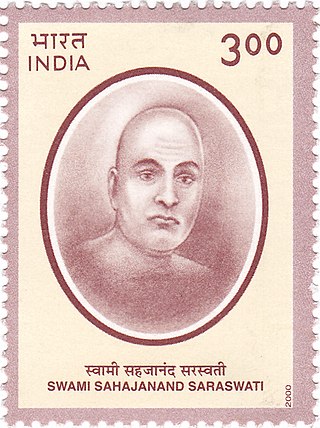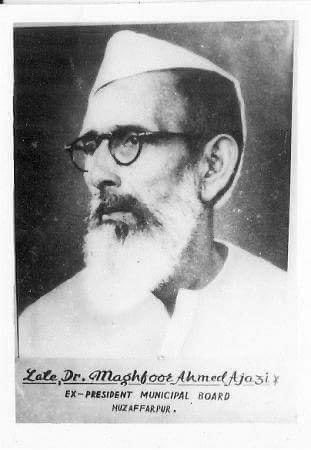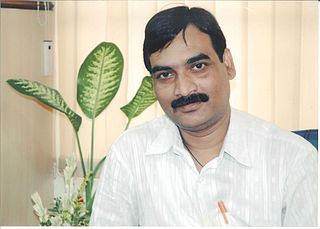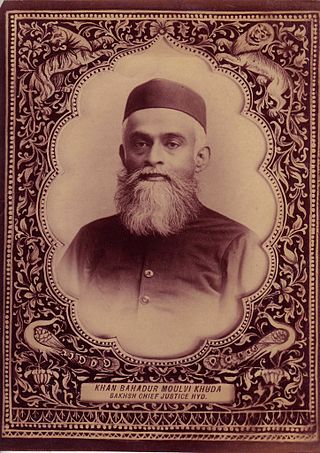
Bihar is a state in eastern India. It is the third largest state by population, the 12th largest by area, and the 14th largest by GDP in 2021. Bihar borders Uttar Pradesh to its west, Nepal to the north, the northern part of West Bengal to the east, and Jharkhand to the south. The Bihar plain is split by the river Ganges, which flows from west to east.

Jagannath Mishra was an Indian politician who served as Chief Minister of Bihar and as Minister in the Union Cabinet. He was also Member of Parliament, Rajya Sabha between 1988 - 1990 and 1994 - 2000. His involvement was at a high level in the Indian National Congress. He was elected Chief Minister of Bihar three times. After his brother L.N. Mishra's assassination, Jagannath Mishra became Bihar's most powerful Congress leader in the late seventies and eighties. Prior to the emergence of Lalu Prasad Yadav in 1990, Jagannath Mishra was rated as the biggest mass leader in the Congress. He was affectionately called "Doctor Sahib". He was also referred to as "Maulana" Jagannath because of his clout with the Muslims that he had earned by making Urdu the second official language of the state in 1980.

Sahajanand Saraswati was an ascetic, a nationalist and a peasant leader of India. Although born in United Provinces, his social and political activities focussed mostly on Bihar in the initial days, and gradually spread to the rest of India with the formation of the All India Kisan Sabha. He had set up an ashram at Bihta, near Patna, Bihar carried out most of his work in the later part of his life from there. He was an intellectual, prolific writer, social reformer and revolutionary.

The Ministry of Culture is the Indian government ministry charged with preservation and promotion of art and culture of India.
Prayag Jha Chillar, also known as Prayag Jha, is a contemporary Indian artist, who specialized in etching. Her works are kept in collections all over India, including the National Gallery of Modern Art in the capital, Delhi. Jha's work was showcased in solo exhibitions from 1971 to 2012 across Jehangir Art Gallery, Taj Art Gallery, Bajaj Art Gallery, and Art Heritage New Delhi. Her work depicts scenes from the ancient Indian epic Meghdoot and is inspired by natural forms, such as grass and leaves. Jha's earlier works were primarily monochrome, but have evolved to include strong colors.

Khuda Bakhsh Oriental Library, in Patna, Bihar, is one of the national libraries of India. It was founded in 1842 by Sir Muhammed Bakhsh and opened to the public on the 28th of October in 1891 by The Honourable Dr. Justice Sir Khan Bahadur Khuda Bakhsh. Its collection started with 4,000 of Bakhsh's own manuscripts, of which he inherited 1,400 from his father, Sir Mohammed Bakhsh, a lawyer from Patna.

Lalit Mohan Sharma was the 24th Chief Justice of India. He was the son of L.N. Sinha, former Attorney General of India. He served as Chief Justice of India from 18 November 1992 until 11 February 1993.
Jyotindra Manshankar Bhatt, better known as Jyoti Bhatt, is an Indian artist best known for his modernist work in painting and printmaking and also his photographic documentation of rural Indian culture. He studied painting under N. S. Bendre and K.G. Subramanyan at the Faculty of Fine Arts, Maharaja Sayajirao University (M.S.U.), Baroda. Later he studied fresco and mural painting at Banasthali Vidyapith in Rajasthan, and in the early 1960s went on to study at the Academia di Belle Arti in Naples, Italy, as well the Pratt Institute in New York. He was awarded the Padma Shri in 2019 and elected as a Fellow of the Lalit Kala Akademi in 2022.

Byomakesh Mohanty was an Indian artist and academic. After completing his science studies and graduating from Utkal University, Bhubaneswar, Orissa, he joined as a faculty of visual arts at Banaras Hindu University.

Patna College is a constituent state aided College of Patna University which was established in 1863 during the British Raj. It offers undergraduate and postgraduate courses in science, arts and commerce as well as some vocational courses like BBA, BMC and BCA. The college is affiliated to Patna University. It is also considered to be the oldest institution of higher education in Bihar.

Sachchidananda Sinha was an Indian lawyer, parliamentarian, and journalist. He was the first President of the Indian Constitutional Assembly which drafted the Constitution of India.

Maghfoor Ahmad Ajazi was a political activist from Bihar, prominent in the Indian independence movement.

Ravindra Prabhat is a Hindi-language novelist, journalist, poet, and short story writer from India.
Ashok Rajpath is a road in Patna, the capital of Bihar. It is named after Ashoka, an Indian emperor of the Maurya Dynasty who ruled almost all of the Indian subcontinent from ca. 269 BCE to 232 BCE. It connects Patna with Patna city or Patna Sahib. Starting roughly from Golghar, it run parallel to the river Ganges, and terminates at the Didarganj. It is a busy road owing to the presence of markets on one side and educational institute of Patna University on the other side.
Ranbir Singh Bisht (1928–1998) was an Indian painter and the Principal of the College of Fine Arts, Lucknow University. Born in 1928 at Landsdowne in Garhwal, in the present day Indian state of Uttarakhand, he secured Drawing Teacher's Training Certificate and Diploma in Fine Arts from the Government College of Art and Craft, Lucknow. He conducted many solo shows in a number of Indian cities besides a show in New York and participated in group shows in Frankfurt and Tokyo. He was also a participant of the 4th Triennale at New Delhi in 1972.
E. Kumaril Swamy was an Indian painter and teacher.
Bismil Azimabadi was an Indian freedom fighter, landlord, and an Urdu poet from Patna, the capital of Bihar.

Sir Khan Bahadur Khuda Bakhsh OIE FRAS was an Indian advocate, judge, philosopher, revolutionary freedom fighter, scholar and historian from Patna, Bihar. He was the founder of Khuda Bakhsh Oriental Library and Chief Justice of Nizam's Supreme Court of Hyderabad from 1895 to 1898. Khuda bakhsh maintains a strong legacy across the Islamic World for his contributions to Literature and History.
Ghulām Muṣṭafā al-Burdwānī, or alternatively Golam Mostafa Bardhamani, was an 18th-century Islamic scholar and poet from Burdwan in western Bengal. He is mentioned in the works of Abd al-Hayy al-Hasani and Muhammad Ishaq Bhatti, where he is described as one of the leading scholars in the fields of Islamic jurisprudence during his time.












